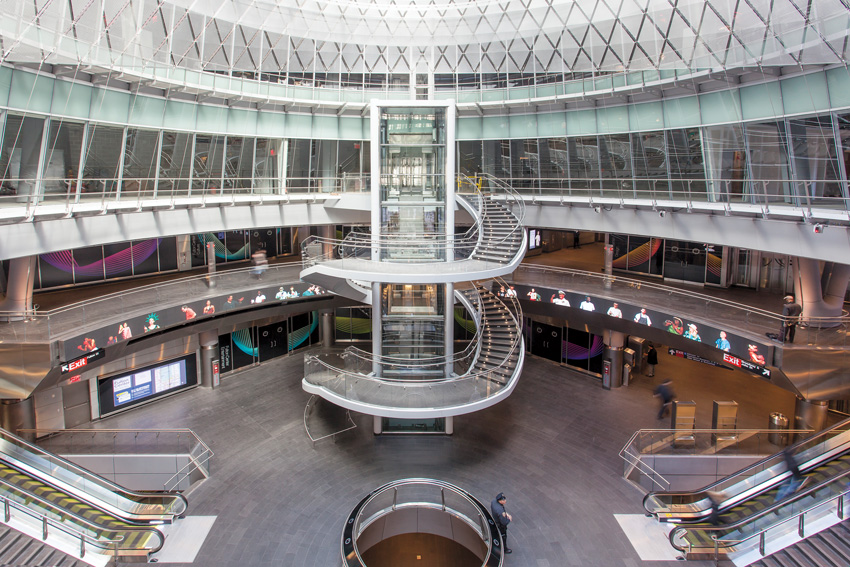The Future of Fire-Rated Glass and Framing
Value of Building with Fire-Resistive Glazing Products
Fire-resistive glazing systems have seen the most number of innovations in recent years. This is due in part because they meet the stringent temperature-rise criteria described above and also pass the test standards for fire-rated wall construction. The fact that they are not limited to 25 percent of the total wall area expands design use.
Additionally, in the last decade, manufacturing advances have given rise to new ways to retain fire-resistive glazing, giving professionals a wide degree of creative design freedom in meeting fire and life safety goals, and providing effective building compartmentation.
Trends and Improvements
Numerous fire-rated glass and framing industry advancements in recent years have set the stage for innovative solutions to be implemented. Before we look in depth at some of those key innovations, let’s take note of some of the trends and challenges that led to the need for those innovations.
- Improved optical quality of fire-rated glazing has stemmed from a transition from traditional wired fire-rated glass to clear fire-rated glass that matches the look of nonrated glazing. Fire-rated glass used to be wired (i.e., it had institutional wires in the glass). As such, the product was simply not as attractive as float glass and also had performance limitations. The wires help hold the glass together under high heat from building fires; however, they do not provide high impact resistance. Injuries can result from people breaking through the glass and getting snagged on the wires. Due to these concerns, the 2003 IBC prohibited traditional wired glass in hazardous locations (e.g., doors, sidelites, windows near the floor in schools, daycares, and athletic facilities). In 2006, the IBC extended this restriction to hazardous locations in all facilities. Over the past two decades, all fire-rated glass manufacturers have worked on creating new, clearer, larger, oversized fire-rated glazing that matches the aesthetic of nonrated glazing and provides critical impact safety.
- Fire-rated frame advances have included the transition from bulky, wraparound, hollow metal steel frames to narrow steel fire-rated frames. For inspiration, manufacturers started looking at how European manufacturers were using precision engineering—that is, taking long steel frames and rollforming them into tubes instead of sheets into very custom-tailored framing systems. Fire-rated frames developed in this way can be much narrower, have crisp edges, and vertical-to-horizontal framing joints without visible weld beads or fasteners. Advanced frames made with thermal insulation and isolation concepts can even earn fire-resistive classifications. So, now they are still fire-rated but also are slender and exceptionally strong due to the strength of steel material.
These improvements have given us stronger frames and larger, clearer fire-rated glass lites, allowing manufacturers to combine the two in a range of different applications in order to create innovative solutions critical to the industry.
For example, designers were once limited to smaller sequences of fire-rated glass, such as doors, sidelites, transoms, and windows. Now, with various fire-resistive glass options and slender, fire-resistive frames at their disposal, they can specify full-lite doors, walls, and floor assemblies, as well as glass installations that exceed 25 percent of the wall area. This includes sophisticated assemblies, such as fire-rated glass floor systems that use a fire-resistive steel framing grid with fire-resistive glass to serve as a code-approved fire barrier between floors and provide sufficient strength to support live, dead, dynamic, and seismic loads.
In addition, fire-resistive glazing products are now multifunctional, providing impact safety, bullet resistance, and even hurricane-resistance.
Five Innovations Changing the Future of Fire-Resistive Glass and Framing
While design professionals need to be aware of both fire-protective and fire-resistive product categories, as previously noted, many recent industry innovations have occurred within the fire-resistive arena as opposed to fire protective. This is due in part to the fact that fire-resistive products pass more codes and give designers more flexibility on the whole.
The following will highlight five innovative solutions in fire-resistive glass and framing systems, including case studies to illustrate each system type.
Narrow-Frame Profiles
Modern fire-rated frames have a slender profile and sleek aesthetic that allow for smooth visual integration with neighboring nonrated applications. Manufacturers are now able to apply thermal insulation and isolation concepts to these fenestration systems, creating narrow frames that earn fire-resistive classifications. When paired with fire-resistive glass, they allow for sophisticated, unlimited areas of glazing in fire separations.
As these innovative updates have taken hold in the industry, today’s fire-rated glass systems have been able to sideline a key design challenge that has traditionally vexed designers in areas requiring fire resistance: creating and maintaining visual harmony between fire-rated and non-fire-rated materials. As previously stated, historically, fire-rated glazing tended to have much thicker frames and glass in order to ensure the required fire protection. Although functional in blocking fire and keeping people safe, they lacked the sleek aesthetic commonly available with non-fire-rated frames. This created visual discrepancies with neighboring nonrated curtain walls, windows, and doors. Fortunately, the advancements we’ve seen in fire-rated frame manufacturing offer solutions to this design challenge. Steel fire-rated frames that are shaped in an extrusion-like process similar to that of other advanced steel frames feature sharp, crisp corners and narrow frame dimensions, enabling a visual match with surrounding applications.
The sleeker aesthetic of steel fire-rated frames is particularly beneficial when the fire-rated glazing is in a highly visible location and can be readily compared to other building elements, such as an expansive curtain wall in an entryway, lobby, or atrium. Crisp frame profiles can also increase internal viewing areas and accentuate the external appearance of modern curtain wall applications, which feature minimalist designs.
Taking integration one step further, some manufacturers are now offering SG fire-rated curtain walls. Such systems feature silicone-sealed glass that provides a smooth, frame-free exterior surface that visually ties with neighboring structural SG curtain wall systems (as discussed later in the course).
Whatever fire-rated frame is selected to match the aesthetic of nonrated systems, it is important to note fire-rated glass requires stiffer frame deflection criteria (under wind load) than nonrated glass. It can also weigh between 100 to 350 percent more than nonrated glass. As a result, design teams may need to increase the framing member size, or reinforce smaller profiles, to limit deflection. This is particularly important when designing fire-rated curtain walls for exterior applications. In instances where a larger profile may restrict the design intent, another viable option is to reinforce the profiles.
However, this can increase the cost of the framing. To aid in finding the best solution, fire-rated framing manufacturers are available to provide design assistance.










